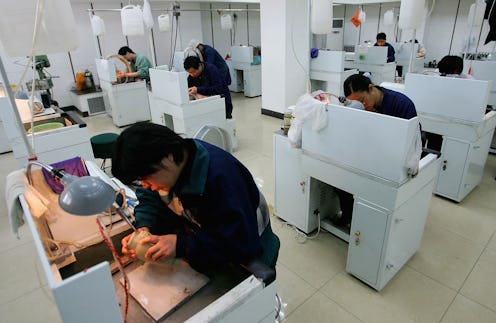Life
6 Reasons The Gender Wage Gap Isn't A Myth
It's tempting to blame the wage gap on faceless corporations — an anonymous CEO may pay women far less than their male coworkers, but surely employers who know their employees by name wouldn't follow suit. Unfortunately, according to a recent study, the wage gap exists in small businesses and startups in the same way as their corporate counterparts. Startups may have a reputation for shaking things up, but clearly that doesn't extend to breaking up the boy's club.
HR company Justworks analyzed data from more than 2,300 small businesses and startups, largely based in New York City, and the results revealed that the wage gap is very much present in these environments. In fact, the gap matches the national average penny for penny: The study found that women are paid an average of 77 cents for every dollar their male counterparts make, which is actually less than this year's commonly-cited national statistic of 79 cents for every dollar. Perhaps unsurprisingly, further analysis showed that women start out making less money than men — a trend that continues for the rest of their careers.
Admittedly, some of this could be attributed to gender differences in career choices. Justworks' research showed that technical and programming roles, which tend to receive higher pay, are overwhelmingly male. In fact, startups were dominated by men in the first place: Out of the businesses surveyed, only 36 percent of employees were women.
However, it's no secret that male-dominated fields, like science and technology, are notoriously difficult for women to break into. Blaming the wage gap on women's career choices alone is counterproductive (and ironic) at best, and a ham-handed attempt to discredit women who speak out at worst. As the research piles up, it's clear that gender disparity in income is far from the myth some make it out to be. Let's take a look at six more statistics showing that the wage gap is disturbingly real.
1. Unconscious Sexism Plays An Important Role
It's absolutely true that women tend to take more time off and are more likely to work part-time, often because they still bear the brunt of housework and childcare. It's also true that women often choose careers that don't make as much money, because they are discouraged from high-earning pursuits like engineering and tech. However, research has shown that even when you account for factors such as education, career choices, and work experience, an inexplicable factor in the wage gap persists. That factor, of course, is old-fashioned gender discrimination.
2. Women Of Color Make Far Less Than White Women
The most common statistic regarding the wage gap comes from the U.S. Census Bureau, which reports that women make 79 cents for every dollar a man makes. While that's true for white women, women of color make far less than that. Black women, for instance, make just 64 cents to a man's dollar, and Latina women earn a paltry 54 cents. In other words, a Latina woman has to work almost twice as much in order to make what a man makes.
3. Motherhood Affects Income
As much as society claims to value motherhood, having a child can have a hugely detrimental effect on a woman's job. This "motherhood penalty," as it's known to social scientists, is the reduction of women's wages beyond the typical wage gap, simply because they have a child. Furthermore, mothers are seen as less reliable and less competent at work. Fathers, on the other hand, suffer no such penalty.
4. It Affects Everyone — Yes, Everyone
You'd think that the wage gap wouldn't affect women in the public eye, but unfortunately, they're as subject to discrimination as anyone else. There are huge salary differences even for female athletes, actors, and even politicians.
5. It's Not Going Anywhere Without Help
Earlier this year, a study found that at the current rate, the wage gap won't close in the United States until 2058. If you think that's bad, brace yourself — a more recent study published last month found that it actually won't close for another 118 years. That's because...
6. It's Widening
Last year, women across the nation celebrated the news that the wage gap was the smallest it had ever been, so you can imagine how crushed we were to hear that in 2015, the gap actually widened once more. This year, men's incomes increased by more than two percent on average, while women's were raised by less than one percent. In fact, the Wall Street Journal reported that last year's narrowing of the gap was largely due to "weak" earnings for men rather than any significant increase in women's income. Yippee.
Images: Giphy (6)
